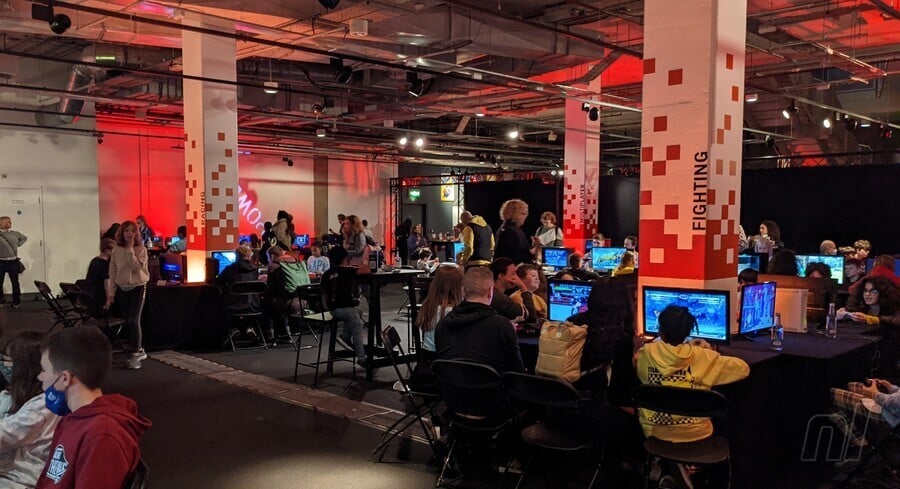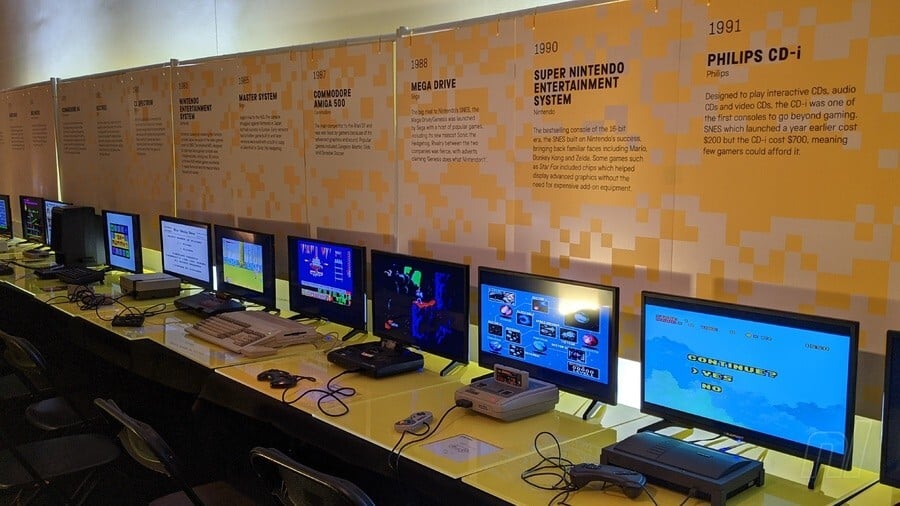
Walking into the Basement Gallery of the London Science Museum, you're greeted by an uncomfortable warmth that often comes with gaming events, but this is soon forgotten when you cast your eyes over the sea of consoles lying in wait. We're all so used to seeing old gaming systems locked away behind glass, perched on a stand with just the right amount of lighting to give them an almost grandiose presence. But what the Power UP exhibition understands, however, is that consoles are meant to be played.
The exhibition itself is open now until April 19th at the Science Museum in South Kensington, London. Entry comes at a small cost, but the good news is that the Science Museum itself is free to explore.
With 160 consoles in total, the exhibition hosts everything from the Binatone TV Master right up to the Nintendo Switch. Everything is out in the open and ready to be played. You can sample classic platformers like Super Mario Bros. and Sonic the Hedgehog, move onto the fighting section with a bit of Street Fighter II and Super Smash Bros. Melee, sample classic racing games like Mario Kart: Double Dash!! and Gran Turismo, before finishing off with the sensory-overloading majesty of PSVR. Granted, with its focus on providing age-appropriate content, you won't find more difficult games like Mega Man 2 or Castlevania III: Dracula's Curse, nor will you find the kind of adult-oriented games like Mortal Kombat that would make the likes of Jack Thompson grumble in disgust; this is a family friendly affair by all accounts.

The main attraction was undoubtedly the 30-year physical timeline of consoles from 1976 (Binatone) to 2006 (Wii). Each console came complete with a short description of its history, along with a brief summary of the game that the systems came loaded with. Again, everything here can be sampled and played, and it's a stark reminder of just how revolutionary the NES was with its controller. Everything prior felt like a bizarre experiment; a strange oddity that — unless you grew up with these systems — feels completely alien. When you consider that every controller since 1985 (or 1983 with Japan's original Famicom) is simply an evolution of Masayuki Uemura's design, feeling that evolution in the flesh is a miraculous experience.
It's a shame, then, that such a fascinating look at the history of video game consoles felt like it was tucked away at the back of the room. This is something that should have been front-and-centre, right when you enter the exhibition. Indeed, given the exhibition's focus on fun and providing entertainment to children, we've a feeling that many will have completely skirted over this section of the room entirely, quite content with sitting at a desk in the opposite corner of the room playing a round of Street Fighter, which is no bad thing in itself!
Then again, we suppose it lets us old fogeys appreciate the more "boring" section of the exhibition, because there's slim chance of playing anything else with all the kids hovering around the screens.
In terms of how Nintendo itself was represented, however, it's safe to say that it was the star of the show. There was plenty of variety on offer, with Mega Drive, PlayStation, Xbox, and Atari all getting their chance to shine, but Nintendo really felt like the dominant presence. There were N64 consoles hooked up with four controllers and a copy of GoldenEye: 007, NES and SNES consoles lined up in rows, GameCube consoles with everything from The Legend of Zelda: Twilight Princess to Super Monkey Ball 2, and small circular desks complete with Game Boy Advance systems hooked up (though these desks were often occupied by bored parents scrolling through FaceBook or — ironically — playing a mobile game).
What was also fascinating to see was just how little patience the younger audience has with a game like Super Mario Bros. Despite the general consensus among fans that World 1-1 is near enough a perfect tutorial for the rest of the game, we witnessed kids just straight up quitting at the first Goomba enemy, dropping the pad back on the desk for the next child to try. Curiously, we'd later see the same kids glued to the screen playing a round of Fortnite, a game that — in our eyes, at least — has a lot more disparate mechanics and systems to learn in open 3D space.
It's a stark indication, perhaps, of how much game tutorials have evolved in recent years and how modern titles bombard players with rewards. For a youngster playing Super Mario Bros., falling at the first hurdle may bring them nothing but a deep sense of frustration, and we witnessed it first hand.
Nevertheless, seeing everyone from middle-aged parents to young toddlers take part in what is essentially a celebration of gaming history is a wonderful sight to behold. With Nintendo in particular, it's easy to sample their legacy games today thanks to the likes of Nintendo Switch Online, but to actually play them in their original form is something that the more casual audience may never get to experience in any other environment. It's an excellent reminder of how far the medium has come, and how much potential has yet to be realised.
The 'Power Up' exhibition is now open at The Science Museum in London until Tuesday, April 19th. Tickets start at £8 and can be bought via the official website.





Comments 19
I sometimes think about how the act of playing video games, especially playing many of them for a number of years, can itself be scientific engagement. A player is engaging with mechanics and cause-and-effect. Over time, a player will witness games with mechanic ideas expanding and branching out. New mechanics spinning off of existing ones. Genres splitting off into sub-genres.
So to see a science museum allowing people to experience a small glimpse of this is really special. It allows younger generations, as well as people who may not have picked up a game in a while, to see how far things have come, and how fun video games from across the years still are today.
I think video games are just really hecking cool.
"it's a stark reminder of just how revolutionary the NES was with its controller"
Before I die I would love for this to a statement wrote about the current controllers.
Can you actually play these retro consoles at the exhibition? If so, I gotta get a ticket to the London Science Museum asap!
Amiga comes back....that amazing....Only in UK can this happen....
Can we please get Paperboy 1, 2, and Paperboy 64 via Nintendo Switch Online! Please and Thank you #Nintendo
Interesting observation on Mario Bros and the Goomba. I wonder if that will change children's brains compared to older generations of gamers? Giving up at the first hurdle isn't great when success is generally learned from failure. Also being given everything on a plate (in terms of tutorials - I don't know how Fortnite works) shapes that mindset, especially at younger ages. Or maybe it was just the old graphics!
I dislike the tutorials on many modern games and think Nintendo still do game openings the best. Breath of the Wild and Metroid Dread were a joy from the start, and the tutorial element didn't feel like it got in the way of the gameplay.
Though I still prefer a printed manual any day.
I could feel it being difficult playing those older non-modded GBA launch models especially with the lack of a light source.
I've been a few times to this in the past and it's been fun but haven't got tickets so far this time. Not sure if the kids get so much out of it now, but cool to be able to access so many past games and machines.
@Specter_of-the_OLED It was very difficult! I'm not sure why they didn't at least opt for the GBA SP.
Looks like fun, but I'll stick with my man cave for my retro gaming fix, as it's less distance to travel!
I went pre-COVID with my 2 sons and brother- we all had a brilliant time (went for the double session).
No Mortal Kombat is a change from last time around - they had a promotional picture of a young girl playing mortal kombat 2 in the previous promotional video!!
Will definitely be trying to go again in 2022.
Great article BTW and interesting insights.
you're greeted by an uncomfortable warmth that often comes with gaming events
@Olliemar28 I'm not sure how to interpret this statement. Surely the consoles themselves aren't generating that much waste heat. Is this a comment about gamers being too friendly and approachable compared to the average Londoner? From my study of the culture, I understand that this can be frightening...
@dew12333 Not that current controllers aren't great, but they're not revolutionary. Almost everything since the NES controller has been iterative of that design. Before the NES, controllers had no D-pad. They either had joysticks or discs. Every good controller since the NES has had a D-pad. That is the definition of revolutionary.
Ok, this is awesome as hell.
I bet not even they could get a PS5. Although of course it's celebrating history, so that may be irrelevant.
@Maulbert
I do remember the nes controller releasing and felt it was similar to the layout for some games played with a keyboard on earlier consoles like the spectrum and commodore. However the benefit it had designing in completely with gaming in mind gave a much more comfortable layout and better feel, and also focused games makers on making games to suit that layout rather than the many different ways you had previously. Before the nes controller the best attempt at a standard way of playing games was the control stick type, these were awful and overall only really worked well for particular types of games.
I would really really like for the industry to invent a new way to play games but fear that the amount of increases in technology required for that will unfortunately mean I will probably die before that happens. Add into that how horrible business is that no one would dare to do it, fearing the games makers wouldn't like it. But overall this is why I am Nintendo fan because they give me the most hope for that.
@AlexHarford I don't remember any tutorials in Fortnite. It just throws you in an arena and you have to live as long as possible. I only played it for 5 hours or so. It was just a run of the mill shooter, nothing particularly special about it other than it being free. And your character is basically randomly assigned to you at the beginning of each match which is really stupid.
@Olliemar28 @Specter_of-the_OLED
Mmm... yes. It should have been the GBA SP ags-101. The perfect blend of form and function.
@CANOEberry it's probably the same sort of 'warmth' that comes from going to conventions too. I've been to a couple of conventions that have had to stress in their blurbs about the importance of maintaining personal hygiene because... well, ugh.
Show Comments
Leave A Comment
Hold on there, you need to login to post a comment...